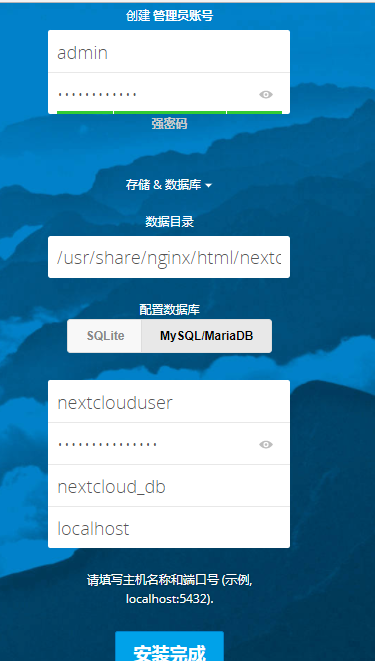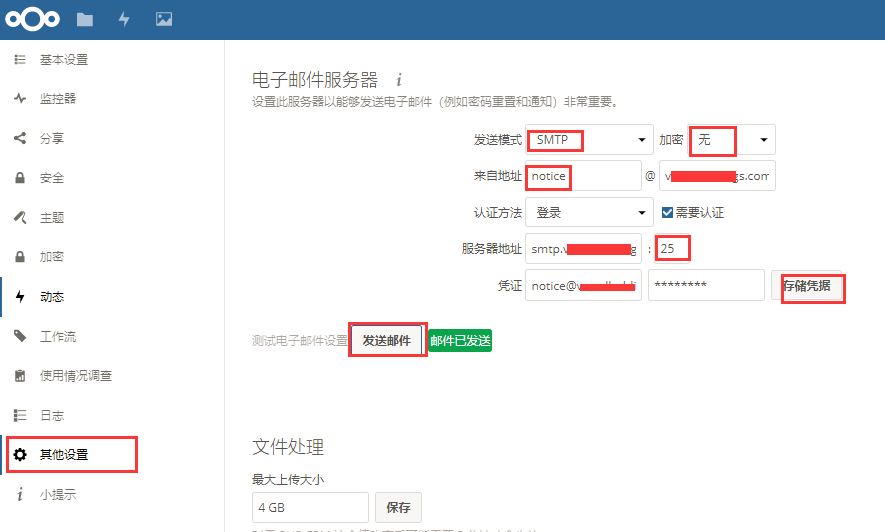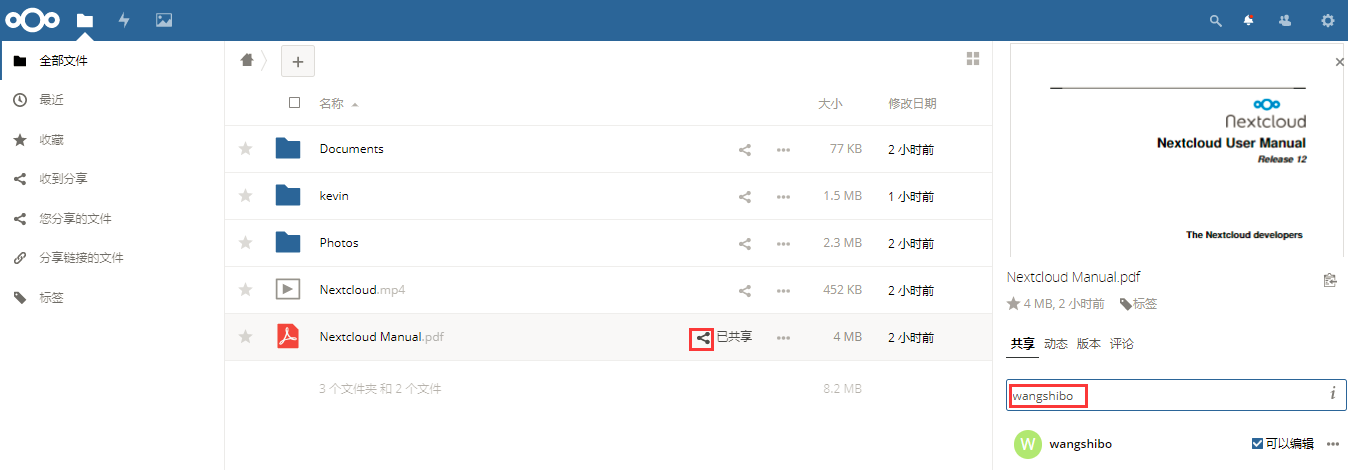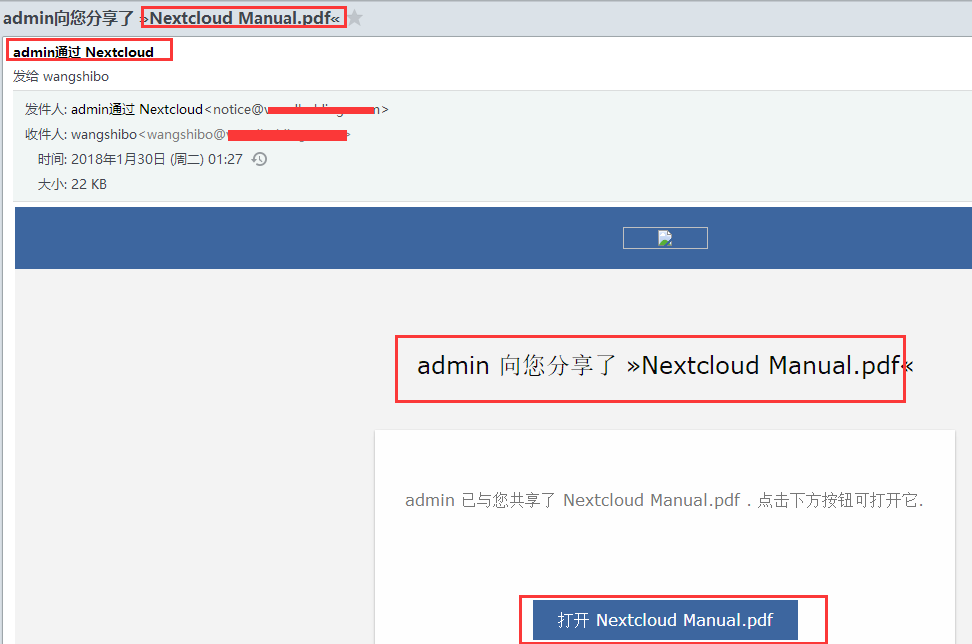搭建个人云存储一般会想到ownCloud,堪称是自建云存储服务的经典。而Nextcloud是ownCloud原开发团队打造的号称是“下一代”存储。初一看觉得“口气”不小,刚推出来就重新“定义”了Cloud,真正试用过后就由衷地赞同这个Nextcloud:它是个人云存储服务的绝佳选择。可以说Nextcloud 是一款自由 (开源) 的类 Dropbox 软件,由 ownCloud 分支演化形成。它使用 PHP 和 JavaScript 编写,支持多种数据库系统,比如 MySQL/MariaDB、PostgreSQL、Oracle 数据库和 SQLite。它可以使你的桌面系统和云服务器中的文件保持同步,Nextcloud 为 Windows、Linux、Mac、安卓以及苹果手机都提供了客户端支持。同时,Nextcloud 也并非只是 Dropbox 的克隆,它还提供了很多附加特性,如日历、联系人、计划任务以及流媒体 Ampache。
与ownCloud相比,Nextcloud的功能丝毫没有减弱,甚至由于可以安装云存储服务应用,自制性更强,也更符合用户的需求。Nextcloud官网的帮助文档写得相当地详细,几乎任何关于Nextcloud的问题都可以找到答案,这说明Nextcloud开发团队确实比ownCloud更加优秀。
一开始以为Nextcloud只是一个网盘云存储,后来看到Nextcloud内置了Office文档、图片相册、日历联系人、两步验证、文件管理、RSS阅读等丰富的应用,我发现Nextcloud已经仅仅可以用作个人或者团队存储与共享,还可以打造成为一个个人办公平台,几乎相当于一个个人的Dropbox了。
以下内容将介绍如何在 CentOS 7 服务器中安装和配置最新版本的 Nextcloud 12,并且会通过 Nginx 和 PHP7-FPM 来运行 Nextcloud,同时使用 MariaDB 做为数据库系统。Nextcloud云盘环境部署后,可以实现web网页端、手机移动端和桌面客户端三者数据同步,其中桌面客户端可以在本地设置一个文件夹,用于同步数据,这样也就相当于在本地备份了数据。同时客户端只要设置开机启动,即只要是启动状态中,它和网页端的数据就是自动同步的。废话不多说了,直接看部署笔记:
1 2 3 4 5 6 7 8 9 10 11 12 13 14 15 16 17 18 19 20 21 22 23 24 25 26 27 28 29 30 31 32 33 34 35 36 37 38 39 40 41 42 43 44 45 46 47 48 49 50 51 52 53 54 55 56 57 58 59 60 61 62 63 64 65 66 67 68 69 70 71 72 73 74 75 76 77 78 79 80 81 82 83 84 85 86 87 88 89 90 91 92 93 94 95 96 97 98 99 100 101 102 103 104 105 106 107 108 109 110 111 112 113 114 115 116 117 118 119 120 121 122 123 124 125 126 127 128 129 130 131 132 133 134 135 136 137 138 139 140 141 142 143 144 145 146 147 148 149 150 151 152 153 154 155 156 157 158 159 160 161 162 163 164 165 166 167 168 169 170 171 172 173 174 175 176 177 178 179 180 181 182 183 184 185 186 187 188 189 190 191 192 193 194 195 196 197 198 199 200 201 202 203 204 205 206 207 208 209 210 211 212 213 214 215 216 217 218 219 220 221 222 223 224 225 226 227 228 229 230 231 232 233 234 235 236 237 238 239 240 241 242 243 244 245 246 247 248 249 250 251 252 253 254 255 256 257 258 259 260 261 262 263 264 265 266 267 268 269 270 271 272 273 274 275 276 277 278 279 280 281 282 283 284 285 286 287 288 289 290 291 292 | 部署机器的系统是Centos7.4版本[root@nextcloud-server ~]# cat /etc/redhat-releaseCentOS Linux release 7.4.1708 (Core) 一、安装并配置Nginx和php-fpm================================================================将自带的epel、nginx、php全部卸载(rpm -e ... --nodeps)[root@nextcloud-server ~]# rpm -qa|grep php[root@nextcloud-server ~]# rpm -qa|grep php-common[root@nextcloud-server ~]# rpm -qa|grep nginx===============================================================CentOS默认的yum源中并不包含Nginx和php-fpm,首先要为CentOS添加epel源:[root@nextcloud-server ~]# yum -y install epel-release[root@nextcloud-server ~]# yum -y install nginx 需要再添加一个yum源来安装php-fpm,可以使用webtatic(这个yum源对国内网络来说恐怕有些慢,当然你也可以选择其它的yum源)[root@nextcloud-server ~]# rpm -Uvh https://mirror.webtatic.com/yum/el7/webtatic-release.rpm 安装php7-fpm和一些其它的必要的组件[root@nextcloud-server ~]# yum -y install php70w-fpm php70w-cli php70w-gd php70w-mcrypt php70w-mysql php70w-pear php70w-xml php70w-mbstring php70w-pdo php70w-json php70w-pecl-apcu php70w-pecl-apcu-devel 完成后,检查一下php-fpm是否已正常安装[root@nextcloud-server ~]# php -vPHP 7.0.25 (cli) (built: Oct 29 2017 13:43:03) ( NTS )Copyright (c) 1997-2017 The PHP GroupZend Engine v3.0.0, Copyright (c) 1998-2017 Zend Technologies 配置php-fpm[root@nextcloud-server ~]# vim /etc/php-fpm.d/www.conf.....user = nginx //将用户和组都改为nginxgroup = nginx.....listen = 127.0.0.1:9000 //php-fpm所监听的端口为9000......env[HOSTNAME] = $HOSTNAME //去掉下面几行注释env[PATH] = /usr/local/bin:/usr/bin:/binenv[TMP] = /tmpenv[TMPDIR] = /tmpenv[TEMP] = /tmp 在/var/lib目录下为session路径创建一个新的文件夹,并将用户名和组设为nginx[root@nextcloud-server ~]# mkdir -p /var/lib/php/session[root@nextcloud-server ~]# chown nginx:nginx -R /var/lib/php/session/[root@nextcloud-server ~]# ll -d /var/lib/php/session/drwxr-xr-x. 2 nginx nginx 4096 1月 25 09:47 /var/lib/php/session/ 启动Nginx和php-fpm服务,并添加开机启动[root@nextcloud-server ~]# systemctl start php-fpm[root@nextcloud-server ~]# systemctl start nginx[root@nextcloud-server ~]# systemctl enable php-fpm[root@nextcloud-server ~]# systemctl enable nginx 二、安装并配置MariaDB使用MaraiDB作为Nextcloud数据库。yum安装MaraiDB服务[root@nextcloud-server ~]# yum -y install mariadb mariadb-server 启动MariaDB服务并添加开机启动[root@nextcloud-server ~]# systemctl start mariadb[root@nextcloud-server ~]# systemctl enable mariadb 接下来设置MariaDB的root密码[root@nextcloud-server ~]# mysql_secure_installation //按照提示设置密码,首先会询问当前密码,密码默认为空,直接回车即可Enter current password for root (enter for none): //直接回车Set root password? [Y/n] YNew password: //输入新密码Re-enter new password: //再次输入新密码 Remove anonymous users? [Y/n] YDisallow root login remotely? [Y/n] YRemove test database and access to it? [Y/n] YReload privilege tables now? [Y/n] Y==============================================================================================或者采用另一种修改密码的方式:跳过授权表1)在/etc/my.cnf文件里添加"skip-grant-tables"2)重启mariadb服务3)无密码登陆mariadb,然后重置mysql密码MariaDB [(none)]> update mysql.user set password=password("kevin@123") where user="root";4)去掉/etc/my.cnf文件里的"skip-grant-tables"内容5)重启mariadb服务6)这样就可以使用上面重置的新密码kevin@123登陆mariadb了============================================================================================== 设置完MariaDB的密码后,使用命令行登录MariaDB,并为Nextcloud创建相应的用户和数据库。例如数据库为nextcloud_db,用户为nextclouduser,密码为nextcloudpasswd:[root@nextcloud-server ~]# mysql -p......MariaDB [(none)]> create database nextcloud_db; MariaDB [(none)]> create user nextclouduser@localhost identified by 'nextcloudpasswd';MariaDB [(none)]> grant all privileges on nextcloud_db.* to nextclouduser@localhost identified by 'nextcloudpasswd';MariaDB [(none)]> flush privileges; 三、为Nextcloud生成自签名SSL证书为SSL证书创建一个新的文件夹:[root@nextcloud-server ~]# cd /etc/nginx/cert/[root@nextcloud-server cert]# openssl req -new -x509 -days 365 -nodes -out /etc/nginx/cert/nextcloud.crt -keyout /etc/nginx/cert/nextcloud.key.....Country Name (2 letter code) [XX]:cn //国家State or Province Name (full name) []:beijing //省份Locality Name (eg, city) [Default City]:beijing //地区名字Organization Name (eg, company) [Default Company Ltd]:kevin //公司名Organizational Unit Name (eg, section) []:Technology //部门Common Name (eg, your name or your server's hostname) []:kevin //CA主机名Email Address []:kevin@wangshibo.cn 然后将证书文件的权限设置为660[root@nextcloud-server cert]# chmod 700 /etc/nginx/cert[root@nextcloud-server cert]# chmod 600 /etc/nginx/cert/* 四、下载并安装Nextcloud[root@nextcloud-server ~]# yum -y install wget unzip[root@nextcloud-server ~]# cd /usr/local/src/[root@nextcloud-server src]# wget https://download.nextcloud.com/server/releases/nextcloud-12.0.4.zip[root@nextcloud-server src]# unzip nextcloud-12.0.4.zip[root@nextcloud-server src]# lsnextcloud nextcloud-12.0.4.zip[root@nextcloud-server src]# mv nextcloud /usr/share/nginx/html/ 进入Nginx的root目录,并为Nextcloud创建data目录,将Nextcloud的用户和组修改为nginx[root@nextcloud-server src]# cd /usr/share/nginx/html/[root@nextcloud-server html]# mkdir -p nextcloud/data/[root@nextcloud-server html]# chown nginx:nginx -R nextcloud/[root@nextcloud-server html]# ll -d nextclouddrwxr-xr-x. 15 nginx nginx 4096 1月 24 17:04 nextcloud 五、设置Nginx虚拟主机进入Nginx的虚拟主机配置文件所在目录并创建一个新的虚拟主机配置(记得修改两个server_name为自己的域名):[root@nextcloud-server ~]# cd /etc/nginx/conf.d/[root@nextcloud-server conf.d]# vim nextcloud.confupstream php-handler { server 127.0.0.1:9000; #server unix:/var/run/php5-fpm.sock;} server { listen 80; server_name nextcloud.kevin-inc.com; # enforce https return 301 https://$server_name$request_uri;} server { listen 443 ssl; server_name nextcloud.kevin-inc.com; ssl_certificate /etc/nginx/cert/nextcloud.crt; ssl_certificate_key /etc/nginx/cert/nextcloud.key; # Add headers to serve security related headers # Before enabling Strict-Transport-Security headers please read into this # topic first. add_header Strict-Transport-Security "max-age=15768000; includeSubDomains; preload;"; add_header X-Content-Type-Options nosniff; add_header X-Frame-Options "SAMEORIGIN"; add_header X-XSS-Protection "1; mode=block"; add_header X-Robots-Tag none; add_header X-Download-Options noopen; add_header X-Permitted-Cross-Domain-Policies none; # Path to the root of your installation root /usr/share/nginx/html/nextcloud/; location = /robots.txt { allow all; log_not_found off; access_log off; } # The following 2 rules are only needed for the user_webfinger app. # Uncomment it if you're planning to use this app. #rewrite ^/.well-known/host-meta /public.php?service=host-meta last; #rewrite ^/.well-known/host-meta.json /public.php?service=host-meta-json # last; location = /.well-known/carddav { return 301 $scheme://$host/remote.php/dav; } location = /.well-known/caldav { return 301 $scheme://$host/remote.php/dav; } # set max upload size client_max_body_size 512M; fastcgi_buffers 64 4K; # Disable gzip to avoid the removal of the ETag header gzip off; # Uncomment if your server is build with the ngx_pagespeed module # This module is currently not supported. #pagespeed off; error_page 403 /core/templates/403.php; error_page 404 /core/templates/404.php; location / { rewrite ^ /index.php$uri; } location ~ ^/(?:build|tests|config|lib|3rdparty|templates|data)/ { deny all; } location ~ ^/(?:\.|autotest|occ|issue|indie|db_|console) { deny all; } location ~ ^/(?:index|remote|public|cron|core/ajax/update|status|ocs/v[12]|updater/.+|ocs-provider/.+|core/templates/40[34])\.php(?:$|/) { include fastcgi_params; fastcgi_split_path_info ^(.+\.php)(/.*)$; fastcgi_param SCRIPT_FILENAME $document_root$fastcgi_script_name; fastcgi_param PATH_INFO $fastcgi_path_info; fastcgi_param HTTPS on; #Avoid sending the security headers twice fastcgi_param modHeadersAvailable true; fastcgi_param front_controller_active true; fastcgi_pass php-handler; fastcgi_intercept_errors on; fastcgi_request_buffering off; } location ~ ^/(?:updater|ocs-provider)(?:$|/) { try_files $uri/ =404; index index.php; } # Adding the cache control header for js and css files # Make sure it is BELOW the PHP block location ~* \.(?:css|js)$ { try_files $uri /index.php$uri$is_args$args; add_header Cache-Control "public, max-age=7200"; # Add headers to serve security related headers (It is intended to # have those duplicated to the ones above) # Before enabling Strict-Transport-Security headers please read into # this topic first. add_header Strict-Transport-Security "max-age=15768000;includeSubDomains; preload;"; add_header X-Content-Type-Options nosniff; add_header X-Frame-Options "SAMEORIGIN"; add_header X-XSS-Protection "1; mode=block"; add_header X-Robots-Tag none; add_header X-Download-Options noopen; add_header X-Permitted-Cross-Domain-Policies none; # Optional: Don't log access to assets access_log off; } location ~* \.(?:svg|gif|png|html|ttf|woff|ico|jpg|jpeg)$ { try_files $uri /index.php$uri$is_args$args; # Optional: Don't log access to other assets access_log off; }} 接下来测试以下配置文件是否有错误,确保没有问题后重启Nginx服务。[root@nextcloud-server conf.d]# nginx -tnginx: the configuration file /etc/nginx/nginx.conf syntax is oknginx: configuration file /etc/nginx/nginx.conf test is successful[root@nextcloud-server conf.d]# systemctl restart nginx 六、为Nextcloud设置Firewalld防火墙和SELinux可以选择关闭Firewalld和SELinux[root@nextcloud-server ~]# systemctl stop firewalld[root@nextcloud-server ~]# systemctl disable firewalld[root@nextcloud-server ~]# setenforce 0[root@nextcloud-server ~]# getenforcedisable[root@nextcloud-server ~]# cat /etc/sysconfig/selinux......SELINUX=disabled 如果打开了防火墙,则需要设置Firewalld和SELinux首先需要安装SElinux管理工具policycoreutils-python[root@nextcloud-server ~]# yum -y install policycoreutils-python 接着设置SELinux[root@nextcloud-server ~]# semanage fcontext -a -t httpd_sys_rw_content_t '/usr/share/nginx/html/nextcloud/data(/.*)?'[root@nextcloud-server ~]# semanage fcontext -a -t httpd_sys_rw_content_t '/usr/share/nginx/html/nextcloud/config(/.*)?'[root@nextcloud-server ~]# semanage fcontext -a -t httpd_sys_rw_content_t '/usr/share/nginx/html/nextcloud/apps(/.*)?'[root@nextcloud-server ~]# semanage fcontext -a -t httpd_sys_rw_content_t '/usr/share/nginx/html/nextcloud/assets(/.*)?'[root@nextcloud-server ~]# semanage fcontext -a -t httpd_sys_rw_content_t '/usr/share/nginx/html/nextcloud/.htaccess'[root@nextcloud-server ~]# semanage fcontext -a -t httpd_sys_rw_content_t '/usr/share/nginx/html/nextcloud/.user.ini'[root@nextcloud-server ~]# restorecon -Rv '/usr/share/nginx/html/nextcloud/' 接下来设置Firewlld防火墙,为Nextcloud开放http和https两个端口[root@nextcloud-server ~]# systemctl start firewalld[root@nextcloud-server ~]# systemctl enable firewalld[root@nextcloud-server ~]# firewall-cmd --permanent --add-service=http[root@nextcloud-server ~]# firewall-cmd --permanent --add-service=https[root@nextcloud-server ~]# firewall-cmd --reload 七、安装Nextcloud解析上面nginx中配置的域名nextcloud.kevin-inc.com,访问访问http://nextcloud.kevin-inc.com进行Nextcloud界面安装(访问http域名会自动跳转到https,安装提示安装即可!) |


==================NextCloud安全与性能优化==================
1 2 3 4 5 6 7 8 9 10 11 12 13 14 15 16 | 这种提示一般在NextCloud的服务器管理中可以看到,建议缓存类的直接安装一个即可,安装多了也没有什么用。为了Nextcloud服务的安全和性能, 请将所有设置配置正确.PHP 模块 ‘fileinfo’ 缺失. 我们强烈建议启用此模块以便在 MIME 类型检测时获得最准确的结果.HTTP 请求头 “Strict-Transport-Security” 没有配置为至少 “15552000” 秒. 出于增强安全性考虑, 推荐按照安全提示中的说明启用HSTS.内存缓存未配置. 如果可用, 需要配置 memcache 以增强性能.PHP 的组件 OPcache 没有正确配置. 为了提供更好的性能, 我们建议在php.ini文件中使用下列设置:opcache.enable=1opcache.enable_cli=1opcache.interned_strings_buffer=8opcache.max_accelerated_files=10000opcache.memory_consumption=128opcache.save_comments=1opcache.revalidate_freq=1 |
==================NextCloud添加Memcached缓存=============
1 2 3 4 5 6 7 8 9 10 11 12 13 14 15 16 17 18 19 20 21 22 23 24 25 26 27 28 29 30 31 32 33 34 35 36 37 38 39 40 | 修改nextcloud程序目录下的config目录中的config.php文件,在配置文件中添加如下,这个是多个Memcached实例,单个自己改: 'memcache.local' => '\OC\Memcache\APCu','memcache.distributed' => '\OC\Memcache\Memcached','memcached_servers' => array( array('localhost', 11211), array('server1.example.com', 11211), array('server2.example.com', 11211), ),==================================================================依据本篇如上安装记录,添加memcache缓存的方法(本机单机安装memcahced)[root@nextcloud src]# yum -y install memcached[root@nextcloud src]# cat /etc/sysconfig/memcachedPORT="11211"USER="memcached"MAXCONN="1024"CACHESIZE="64"OPTIONS=""[root@nextcloud src]# systemctl start memcached[root@nextcloud src]# systemctl enable memcachedCreated symlink from /etc/systemd/system/multi-user.target.wants/memcached.service to /usr/lib/systemd/system/memcached.service.[root@nextcloud src]# lsof -i:11211COMMAND PID USER FD TYPE DEVICE SIZE/OFF NODE NAMEmemcached 146026 memcached 26u IPv4 3320544 0t0 TCP *:memcache (LISTEN)memcached 146026 memcached 27u IPv6 3320545 0t0 TCP *:memcache (LISTEN)memcached 146026 memcached 28u IPv4 3320549 0t0 UDP *:memcachememcached 146026 memcached 29u IPv6 3320550 0t0 UDP *:memcache修改nextcloud的config配置文件,添加memcached缓存配置[root@nextcloud config]# pwd/usr/share/nginx/html/nextcloud/config[root@nextcloud config]# cp config.php config.php.bak[root@nextcloud config]# vim config.php...... 'memcache.local' => '\OC\Memcache\APCu', 'memcache.distributed' => '\OC\Memcache\Memcached', 'memcached_servers' => array( array('localhost', 11211), ), |
==================NextCloud添加Redis缓存==================
1 2 3 4 5 6 7 8 9 10 11 12 13 14 15 16 17 18 19 | 在nextcloud的config配置文件中添加如下,这个是通过TCP连接的:'memcache.local' => '\OC\Memcache\Redis','redis' => array( 'host' => 'localhost', 'port' => 6379, ),还有性能更好的UNIX连接:'memcache.local' => '\OC\Memcache\Redis','redis' => array( 'host' => '/var/run/redis/redis.sock', 'port' => 0, 'dbindex' => 0, 'password' => 'secret', 'timeout' => 1.5, ),同时,官方还推荐加入如下,来用于存储文件锁:'memcache.locking' => '\OC\Memcache\Redis', |
========Nextcloud的邮件发信设置========
Nextcloud发送邮件信息的前提:每个用户(包括管理员)都要事先设置好自己的邮箱地址!
1)使用管理员账号登陆Nextcloud。点击右上角的设置图标里的"管理"-"其他设置"

前提是管理员(admin)要事先设置好自己的邮箱地址。如下设置好邮箱地址后,按Enter键后就会显示一个"对勾"

满足条件:
1 2 3 | 1)在admin登陆后的"管理"->"其他设置"的后台里配置好"电子邮件服务器"(配置后可以测试发送邮件是否成功,前提是admin也要事先配置好自己的邮箱地址)2)各用户创建并登陆后,要记得配置各自的邮箱地址。比如wangshibo用户登录后,配置自己的邮箱地址3)在分享文件的时候,只要使用对方账号名进行分享,对方邮箱里就会收到一封分享信息的邮件! |
如下,在admin账号下分享Nextcloud Manual.pdf这个文件给wangshibo用户

然后登陆wangshibo用户,就会发现Nextcloud Manual.pdf文件已经分享过来了

登陆wangshibo账号配置的邮箱,就会发现有上面分享的邮件信
也可以在文件来源方取消分享

==========云盘上传文件大小限制==============
nextcloud上传文件大小的自身限制为512M,如果要想调整这个大小,操作方法如下:
1 2 3 4 5 6 7 8 9 10 11 12 13 14 15 16 17 18 19 | 1)修改php.ini上传文件大小限制[root@nextcloud ~]# vim /etc/php.ini......max_execution_time = 0 #默认是30秒,改为0,表示没有限制......post_max_size = 10800M #设定 POST 数据所允许的最大大小,如果POST数据尺寸大于post_max_size $_POST 和 $_FILES superglobals 便会为空.......upload_max_filesize = 10240M #表示所上传的文件的最大大小#另外要说明的是,post_max_size 大于 upload_max_filesize 为佳.2)修改nginx.conf[root@nextcloud ~]# vim /etc/nginx/conf.d/nextcloud.conf.....client_max_body_size 10240M;3)重启php和nginx服务[root@nextcloud ~]# systemctl restart php-fpm[root@nextcloud ~]# systemctl restart nginx |
==========云盘创建新用户==============
碰到一个问题:在admin管理员登录nextclod,点击右上角的"用户",创建新用户时候,点击"创建"无反应,即无法在web界面里创建新用户!
此时可以去数据库中创建新用户:
1 2 3 4 5 6 7 8 9 10 11 12 13 14 15 16 17 18 19 20 21 22 23 24 25 26 27 28 29 30 31 32 33 34 35 36 37 38 39 40 41 42 43 44 45 46 47 48 49 50 51 52 53 54 55 56 57 58 59 60 61 62 63 64 65 | [root@nextcloud ~]# mysql -pnextcloud@123Welcome to the MariaDB monitor. Commands end with ; or \g.Your MariaDB connection id is 53445Server version: 5.5.56-MariaDB MariaDB ServerCopyright (c) 2000, 2017, Oracle, MariaDB Corporation Ab and others.Type 'help;' or '\h' for help. Type '\c' to clear the current input statement.MariaDB [(none)]> show databases;+----------------------+| Database |+----------------------+| information_schema || binlog || mysql || #mysql50#mysql.mysql || nextcloud_db || performance_schema |+----------------------+6 rows in set (0.00 sec)MariaDB [(none)]> use nextcloud_db;Reading table information for completion of table and column namesYou can turn off this feature to get a quicker startup with -ADatabase changedMariaDB [nextcloud_db]> select * from oc_users;+--------------+---------------------------+----------------------------------------------------------------+| uid | displayname | password |+--------------+---------------------------+----------------------------------------------------------------+| admin | NULL | 1|$2y$10$EeJacmgPRJW1VWcJVyEtA.u37fjWh3YRLvSKN1fxtdYDxRUdM4pSu || kevin | 信息科技部-kevin | 1|$2y$10$GA18mMkIyZ58eDvE/e6eMuQMJQyWP7BgwyhymuUpykDgWLKQdFotC || grace | 信息科技部-grace | 1|$2y$10$eCsuuK.ZrWx7qGrMKi88l.myL6GAj33TYtJ9x288SWq7qx25xiFN2 |添加新用户"wangshibo",密码为"wangshibo@123"MariaDB [nextcloud_db]> insert into oc_users(uid,password) valuses("wangshibo","wangshibo@123");再次查看:MariaDB [nextcloud_db]> select * from oc_users;+--------------+---------------------------+----------------------------------------------------------------+| uid | displayname | password |+--------------+---------------------------+----------------------------------------------------------------+| admin | NULL | 1|$2y$10$EeJacmgPRJW1VWcJVyEtA.u37fjWh3YRLvSKN1fxtdYDxRUdM4pSu || kevin | 信息科技部-kevin | 1|$2y$10$GA18mMkIyZ58eDvE/e6eMuQMJQyWP7BgwyhymuUpykDgWLKQdFotC || grace | 信息科技部-grace | 1|$2y$10$eCsuuK.ZrWx7qGrMKi88l.myL6GAj33TYtJ9x288SWq7qx25xiFN2 || grace | NULL | wangshibo@123 |发现在数据库中创建的新用户的密码是明文保存的。接着用admin管理员登录nextcloud,点击右上角"用户",就能看到上面在数据库中新创建的wangshibo用户了,然后在这里重置密码!(重置密码时,输入新密码,然后按"Enter"键回车即可),最后确保用新重置的密码登录wangshibo账号的云盘。wangshibo账号登录成功后,再登录数据库发现,该用户的密码就会密文保存了!========================================================================创建用户组的正确方法:点击右上角"用户",在"分组"->"添加分组"。也可以登录数据库里创建:MariaDB [nextcloud_db]> select * from oc_groups;MariaDB [nextcloud_db]> insert into oc_groups values("运维组");可以将新用户分组到对应的组内,也可以禁用或删除用户。点击左下角的"设置",可以显示用户的存储目录,邮件地址等。 |





















